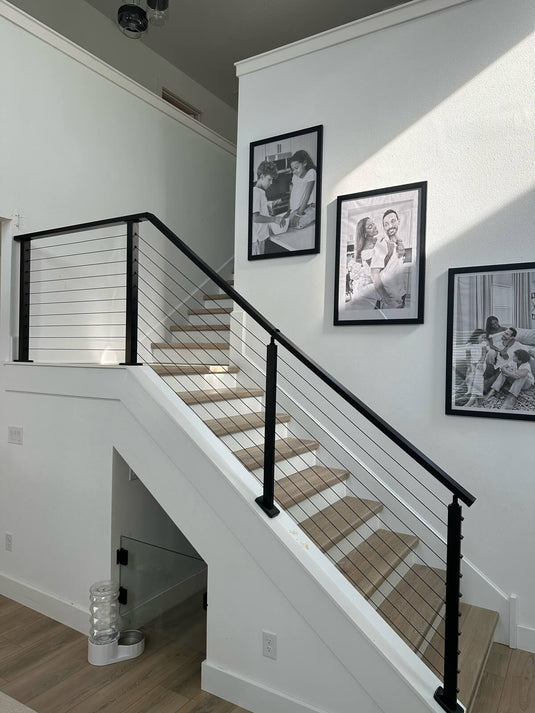TABLE OF CONTENTS
How the Minimalist Design of Floating Stairs Supports Sustainability?
Floating stairs are today the pinnacle of modern architecture, coveted for their sleek, minimalist elegance and ingenuity. Beyond looks, such architectural features are vital in the quest for sustainability through the efficient use of materials, innovative structural concepts, and energy-saving technologies. This piece delves into how floating stairs reflect sustainable practice through the maximization of resource utilization, the use of energy-efficient elements, and smooth integration into green building codes, showcasing the beautiful fusion of aesthetics and eco-friendliness with the "less is more" philosophy.

1. Material Efficiency and Recyclability
Lightweight, High-Strength Materials
Floating stairs often use materials like steel, glass, and carbon fiber, chosen for their excellent strength-to-weight ratios. These materials are not only durable but also help minimize resource consumption in construction. For instance, steel is highly recyclable, with a recycling rate exceeding 90%, effectively reducing waste and the need for new raw materials. Glass, when tempered, provides both structural integrity and aesthetic transparency, and it can be recycled through remelting processes, further contributing to sustainable building practices.
Sustainable Natural Materials
Other than high-technology materials, floating stairs also sometimes feature natural materials like marble and FSC wood. Marble brings timeless beauty and durability, with cutting processes adjusted to avoid wastage and get the most out of it, like a minimum thickness of 2 cm and chamfering to increase its lifespan. The wood used in such constructions is mostly sourced from sustainably managed forests to bring an eco-friendly footprint. Precision cutting minimizes waste while obtaining materials through certified suppliers on the part of architects minimizes environmental impacts. Together, the measures demonstrate just how cautious use of materials will lead to a more environmentally friendly architecture.
2. Structural Design Innovation
Floating staircases employ innovative hidden support systems that eliminate traditional columns in favor of hidden load-bearing elements like longitudinal beams and embedded steel plates. Apart from the enhanced appearance that gives the impression of floating, the design is also more material-efficient. Through the elimination of bulky supports, the systems reduce the need for excess materials like steel and concrete, thus reducing the consumption of resources. The minimalist design balances beauty and durability and renders the structure an environmentally friendly choice.
Sustainability in floating staircases is primarily achieved through prefabricated components, which offer a significant reduction of construction waste and emissions. Components like steel frames and steps are manufactured off-site and subsequently assembled on-site, minimizing resource consumption and on-site labor. Advances such as reducing the base layer thickness from the standard 10-15cm to just 5-8 cm are some of the methods by which prefabrication can be used to further reduce material consumption. In addition to speeding up the construction process, this technique also enables a higher degree of accuracy and quality control, which contributes to the sustainability of the building project overall.

3. Energy Efficiency and Maintenance
Lighting
Integrating natural and intelligent lighting systems into floating stair designs significantly enhances their energy efficiency. Glass railings and translucent steps allow for the maximum influx of natural light, reducing the need for artificial lighting during daylight hours. This design choice not only cuts down on electricity usage but also creates a more inviting and open atmosphere.
Additionally, many modern floating stairs incorporate LED lighting, strategically placed to highlight the staircase while consuming minimal energy. These LEDs provide warm, long-lasting illumination (with lifespans of up to 50,000 hours), which helps in further reducing both operational costs and environmental impact. By combining aesthetic appeal with practical functionality, these lighting choices underscore the role of thoughtful design in promoting sustainability.
Durability
The durability of floating stairs is another crucial factor in their sustainable design. Using combinations like steel frames paired with marble ensures these structures can last for decades—often exceeding a lifespan of 30 years. Such longevity means fewer resources are needed over time for repairs or replacements.
Protective coatings and treatments, such as epoxy resin applications, help maintain these materials' appearance and integrity, reducing the frequency of cleaning and the necessity for chemical cleaners. This reduction in maintenance needs ultimately contributes to a lower ecological footprint, emphasizing the importance of choosing durable materials and finishes as part of a comprehensive sustainability strategy. By focusing on durability, architects ensure that floating stairs remain a viable, eco-friendly choice in modern construction.
4. Space Utilization and Ecological Compatibility
Enhance Space Perception
Floating stairs significantly enhance the perception of space within a building. By eliminating the need for bulky columns and supports, these staircases offer an open, airy look that can make even small areas feel more expansive. This design feature not only adds aesthetic value but also reduces the need for additional construction materials typically required by traditional staircases. The minimalist approach allows architects to maximize usable space while requiring less square footage, which subsequently decreases the overall volume and mass of the building. As a result, there is a reduction in resource consumption during both the initial construction and the lifecycle of the building. This thoughtful integration into architectural design demonstrates how floating stairs can contribute to a more sustainable built environment by fostering efficient space use.
Adhere to Green Building Standards
Integrating green building standards into the design of floating stairs further enhances their sustainability. Many designs prioritize energy-efficient lighting, such as LED strips with motion sensors, to minimize power consumption. Additionally, the use of eco-friendly materials and compliance with LEED or similar green certifications contribute to a lower environmental impact.
Current trends also explore the use of recycled materials like glass and bamboo, pushing the boundaries of what’s possible with eco-friendly designs. By meeting or exceeding green building standards, floating stairs not only contribute to sustainability goals but also encourage innovation in material usage and building design. This commitment to ecological compatibility ensures that these structures remain at the forefront of environmentally conscious architecture.

Conclusion
Floating stairs aptly epitomize the "less is more" concept, blending elegance with environmental responsibility with ease. With their minimalist design, they achieve maximum space and resource utilization, and green-friendly materials and innovative technologies reduce the environmental impact. With increasing popularity, the designs are bound to leave a greater mark on architectural trends as a whole towards sustainability, encouraging innovative interventions that balance beauty with concern for the environment in modern construction projects.




